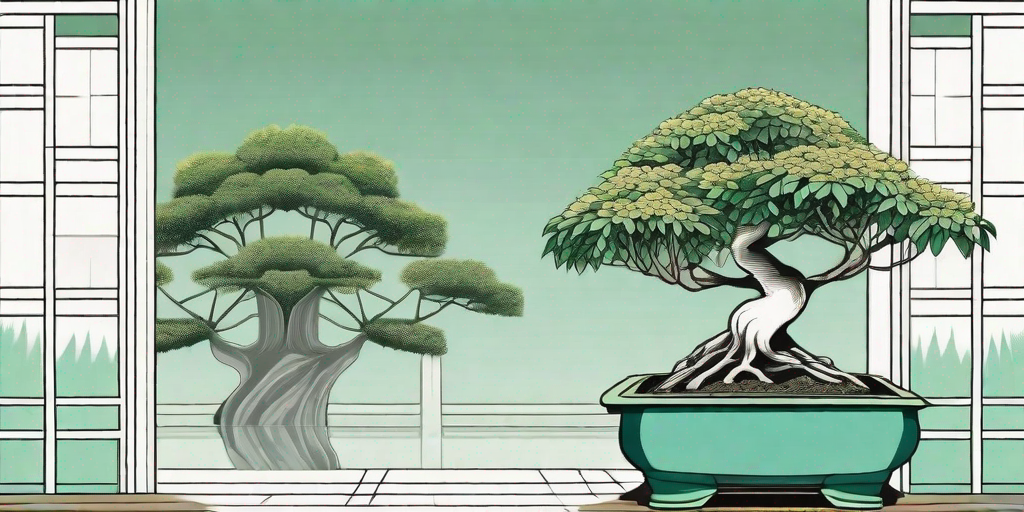
Welcome, green-thumbed Zen seekers! You're about to embark on a journey of growth and tranquility with the Schefflera Bonsai, a miniature tree that's as charming as it is easy to care for. So, roll up your sleeves, put on your favorite gardening hat, and let's dive into the world of bonsai!
Understanding the Schefflera Bonsai
The Schefflera Bonsai, also known as the Umbrella Tree, is a popular choice for bonsai enthusiasts. It's a tropical plant, which means it loves warmth and humidity, but it's also surprisingly hardy. The Schefflera Bonsai is like that friend who's always up for an adventure, but also doesn't mind a cozy night in.
One of the unique features of the Schefflera Bonsai is its glossy, umbrella-shaped leaves. These leaves not only add a touch of elegance to your bonsai, but they also act as a mini-umbrella for the tree, helping it retain moisture. It's like having a built-in watering system!
The Origin of the Schefflera Bonsai
The Schefflera Bonsai originates from Taiwan and South China, where it grows in the wild. It's a bit of a globetrotter, though, and has made its way to homes and gardens around the world. It's not picky about its surroundings, making it an ideal choice for bonsai beginners.
Despite its exotic origins, the Schefflera Bonsai is not a diva. It's a low-maintenance plant that's happy to adapt to its environment. It's like the laid-back roommate of the plant world.
Growing Your Schefflera Bonsai
Now that you're acquainted with the Schefflera Bonsai, it's time to roll up your sleeves and get your hands dirty. Don't worry, though, this tree is more of a friend than a foe. It's not going to give you a hard time.
First things first, you'll need to get a Schefflera Bonsai. You can either buy a pre-grown bonsai or start from scratch with seeds or a cutting. If you're a beginner, we recommend starting with a pre-grown bonsai. It's like getting a head start in a race.
Planting Your Schefflera Bonsai
Once you have your Schefflera Bonsai, it's time to plant it. You'll need a shallow bonsai pot with good drainage. Fill the pot with a bonsai-specific soil mix, which is usually a combination of akadama, pumice, and lava rock. This mix ensures good drainage and provides the nutrients your bonsai needs to thrive.
Place your bonsai in the pot and cover the roots with more soil. Make sure the tree is firmly in place but not too tightly packed. It's like tucking in a child - snug but not suffocating.
Watering Your Schefflera Bonsai
Watering is a crucial part of bonsai care. The Schefflera Bonsai likes to stay moist but not waterlogged. It's a bit like Goldilocks - it likes its water just right.
A good rule of thumb is to water your bonsai when the top inch of soil feels dry. It's better to water thoroughly and less frequently than to water a little bit every day. Overwatering can lead to root rot, which is like a cold for your bonsai.
Caring for Your Schefflera Bonsai
Now that your Schefflera Bonsai is all settled in, it's time to learn about ongoing care. This includes things like pruning, repotting, and dealing with pests. It's like raising a child, but with less backtalk.
Pruning Your Schefflera Bonsai
Pruning is an essential part of bonsai care. It helps maintain the tree's shape and promotes healthy growth. It's like giving your bonsai a haircut.
Use sharp, clean shears to prune your bonsai. Cut back the new growth to maintain the tree's shape. Don't be afraid to get creative with your pruning. After all, your bonsai is a work of art!
Repotting Your Schefflera Bonsai
Every few years, your Schefflera Bonsai will outgrow its pot. When this happens, it's time to repot. This involves removing the tree from its pot, trimming the roots, and replanting it in fresh soil. It's like moving house, but for your bonsai.
Repotting is best done in early spring, just before the growing season starts. This gives your bonsai time to recover before it starts putting out new growth.
FAQs About Schefflera Bonsai
- Can I grow a Schefflera Bonsai indoors?
Yes, the Schefflera Bonsai is a great indoor plant. It likes bright, indirect light and can tolerate a range of temperatures. Just make sure it's not in a drafty spot or near a heat vent.
- How often should I fertilize my Schefflera Bonsai?
Fertilize your bonsai every two weeks during the growing season (spring and summer) and once a month during the dormant season (fall and winter). Use a balanced, water-soluble fertilizer.
- What should I do if my Schefflera Bonsai has pests?
If you notice pests on your bonsai, treat it with an insecticidal soap or neem oil. Be sure to isolate the affected tree from other plants to prevent the pests from spreading.
Conclusion
And there you have it, folks! Everything you need to know to grow and care for your very own Schefflera Bonsai. Remember, bonsai is not just about growing a tree; it's about cultivating patience, mindfulness, and a sense of Zen. So, go forth and bonsai!
And remember, if your Schefflera Bonsai throws a tantrum (yes, plants can do that), just remind it that you're the boss. After all, you're the one with the watering can.















